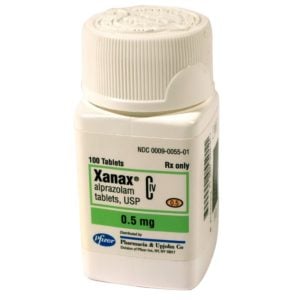In 1988, several studies on Xanax (alprazolam) were published.
In the first study, Xanax (alprazolam) was studied in a large, placebo-controlled, eight-week, flexible-dose trial in patients with agoraphobia with panic attacks and panic disorder. At week 8, Xanax was no better than placebo for panic attacks. However, the researchers tried to hide this by using an “endpoint analysis” which intentionally favors the Xanax group by considering people who dropped out of the study in the placebo group as “nonresponders.”
The second Xanax study from 1988 demonstrated high rates of side effects in a substantial number of patients receiving alprazolam (Xanax), primarily sedation, fatigue, ataxia, slurred speech and amnesia. Despite these health concerns, the researchers report “patient acceptance of alprazolam […] was high.” Their evidence: simply that their participants didn’t leave the study.
In the third Xanax study from 1988, patients with panic disorder and phobic avoidance received either alprazolam (Xanax) or placebo in doses of 2 to 10 mg daily for eight weeks. After a 4-week taperfrom the drug, the Xanax patients deteriorated significantly. Those who never took Xanax continued improving, down to less than 2 panic attacks on average, while those who took Xanax and then discontinued went up to almost 7 panic attacks each, on average. Overall anxiety also worsened for the subjects exposed to Xanax.
In a 1989 summary of the above three studies, the authors (psychologists and psychiatrists from several countries) wrote “Alprazolam had no significant effect at week 8 on most completer analyses, and all gains were lost once the drug therapy was stopped. Moreover, at the last week after taper, patients receiving alprazolam were in a worse state than patients receiving placebo, in terms of panic (350% worse, in Table 1 of the article by Pecknold et al), phobias, and Hamilton anxiety (other measures were not reported).”
In 1993, Dr. Isaac Marks and Dr. Richard Swinson led a study to determine the efficacy of the benzodiazepine class drug, alprazolam, marketed under the brand name, Xanax, by its developer, Upjohn. The study was published in the high profile journal British Journal of Psychiatry and reported on two separate pools of patients from London and Toronto. Upjohn marketed Xanax for the treatment of panic disorder, and they funded Marks and Swinson’s study hoping to show that Xanax worked better than placebo. However, a close look at the 14-week London/Toronto study reveals that Xanax, rather than provide a benefit to patients, caused a significant amount of harm. And on panic measures, the placebo (control group) was the best treatment! A reply by Marks, Swinson et al. to a comment on their published study states “At week 8, exposure therapy [a non-drug psychotherapy] was twice more effective than alprazolam on non-panic measures, both in London and in Toronto (neither treatment did better on panics than the double-placebo, which reduced panics so effectively). This conclusion is reliable.” The authors also note that their support was suddenly taken away by the pharmaceutical industry once they found results that the industry didn’t like, and in fact the pharmaceutical company (Upjohn) who had supported their study invited others to critique it and try to discredit it! More details about this study, including commentary from Marks and Swinson, can be found here. An article, authored by journalist Robert Whitaker, further discusses this study, including how Upjohn’s investigators attempted to turn the results into evidence that Xanax was “safe and effective” by reporting on the 4-week results only.
We thank the team at Medicating Normal for allowing us to reprint this summary.

